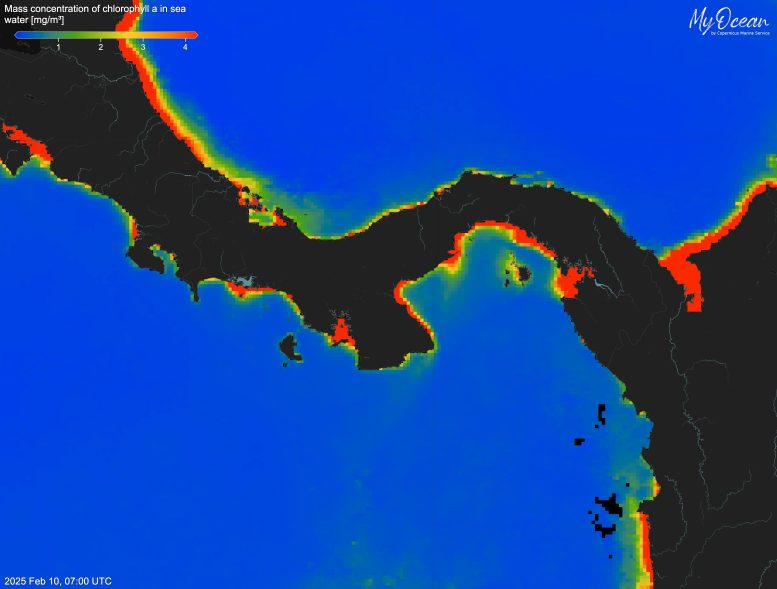Panama’s Ocean Lifeline: First Recorded Collapse of Seasonal Upwelling in 40 Years

For the first time in at least four decades of consistent monitoring, the seasonal upwelling in the Gulf of Panama has failed. This event, which occurred in early 2025, is more than a small disruption in a natural cycle—it represents a serious warning about the sensitivity of tropical ocean systems to climate variability. A research team from the Smithsonian Tropical Research Institute (STRI) and their collaborators documented this breakdown in detail and published their findings in Proceedings of the National Academy of Sciences (PNAS).
Let’s break down what this means, what exactly happened, why it happened, and why it matters—not just for Panama, but for the global climate system and the communities that depend on these vital waters.
What Normally Happens in the Gulf of Panama
Each year, between January and April, Panama enters its dry season. During this period, strong northerly trade winds sweep across Central America and funnel through the narrow Isthmus of Panama. This wind jet, sometimes referred to as the Panama low-level jet, drives a process called upwelling.
Upwelling occurs when surface waters are pushed aside by wind, allowing cold, nutrient-rich waters from the ocean’s depths to rise. The results are significant:
- Fisheries thrive, since nutrient-rich waters fuel phytoplankton growth, which forms the base of the marine food chain.
- Coral reefs are shielded from heat stress, as cooler waters keep temperatures lower than they would otherwise be.
- The Pacific coast cools during Panama’s vacation season, making the region’s “summer” months noticeably more pleasant.
This cycle has been so reliable that researchers have documented it without fail for over 40 years—until 2025.
What Went Wrong in 2025
The 2025 season broke with this long-standing rhythm. Instead of the usual, months-long upwelling, the event was delayed, shortened, and drastically weakened. Here are the specifics observed by the researchers:
- Timing: The upwelling began 42 days later than the historical average.
- Duration: It lasted only 12 days, compared to the normal 66 days—an 82% reduction.
- Temperature shifts: Minimum sea surface temperatures (SSTs) were about 23.3°C, far warmer than historical lows that sometimes dipped to 14.9°C.
- Cold-day accumulation: The number of days with SSTs below 25°C was the lowest ever recorded.
Wind dynamics were also highly unusual. While the winds that did blow were just as strong as usual, they were much less frequent. In fact:
- Northerly winds dropped in frequency by about 74%.
- Wind relaxations (calm periods) increased by about 25%.
- Cumulative wind forcing, the total momentum pushing the upwelling, was severely reduced.
As a result, the driving engine behind upwelling simply never gathered the momentum needed to sustain it.

Data and Evidence Behind the Findings
This isn’t speculation—it’s based on multiple, independent sources of data:
- Satellite records: Over 40 years of sea surface temperature (SST) satellite data clearly show 2025 as a historic outlier.
- In-situ temperature loggers: Around 30 years of ocean sensor data confirmed the abnormal warmth and lack of cooling.
- Ocean profiles: Direct water sampling from the research vessel S/Y Eugen Seibold added crucial confirmation.
This multi-layered evidence gives researchers high confidence that the 2025 breakdown was real and unprecedented.
What Might Have Caused This?
The immediate cause is linked to unusual atmospheric circulation patterns. Specifically, the Panama wind jet became far less frequent. While the exact mechanism is still under investigation, scientists point to the Intertropical Convergence Zone (ITCZ) and its shifting position during the 2024–2025 La Niña event as possible drivers.
The ITCZ strongly influences tropical trade winds. If its position shifted abnormally, that could have disrupted the pathways that generate Panama’s upwelling. Still, researchers caution that the exact causes remain uncertain, and more study is needed to understand whether this is a rare anomaly or part of a larger pattern linked to climate change.
Why This Matters
The collapse of upwelling in Panama is not just a local curiosity. It has major ecological, economic, and climate implications.
Fisheries and Food Webs
Without upwelling, phytoplankton productivity plummets. Since phytoplankton are the foundation of the food web, this could lead to declines in fish populations. Many coastal communities in Panama depend directly on fisheries for food and income, making this more than just an environmental issue—it’s also a food security and livelihood issue.
Coral Reefs and Marine Ecosystems
Upwelling provides a cooling buffer that protects coral reefs from thermal stress. Without it, reefs may face higher risks of bleaching and decline, especially in years when global sea temperatures are elevated.
Climate Feedbacks
Seasonal upwelling also plays a role in regional climate regulation, keeping coastal waters cooler and influencing weather patterns. Its absence may mean hotter coastal conditions, with ripple effects on both ecosystems and human activities.
A Warning Signal
This event highlights the vulnerability of tropical upwelling systems, which are often less studied and monitored than the famous systems off California, Peru, or West Africa. If a relatively small but consistent system like Panama’s can suddenly collapse, it raises concerns about what might happen in other tropical regions under intensifying climate change.
Research Collaboration
The 2025 study was the product of a large scientific effort:
- Led by the Smithsonian Tropical Research Institute (STRI).
- Supported by the Max Planck Institute for Chemistry, which provided the research vessel S/Y Eugen Seibold.
- Contributors included researchers such as Aaron O’Dea, Andrew J. Sellers, Carmen Pérez-Medina, Javier Pardo Díaz, Alexandra Guzmán Bloise, Christopher Pöhlker, Michał T. Chiliński, Hedy M. Aardema, Jonathan D. Cybulski, Lena Heins, Steven R. Paton, Hans A. Slagter, Ralf Schiebel, and Gerald H. Haug.
In addition, data from ERA5 atmospheric reanalysis was used to confirm how anomalous the 2025 wind behavior was.
Broader Context: What Is Upwelling and Why Is It Important?
To put Panama’s case into perspective, let’s take a closer look at upwelling systems in general.
- Definition: Upwelling is the process by which deep, cold, nutrient-rich waters rise to the surface, replacing the warmer surface waters displaced by wind.
- Nutrient cycling: These nutrients (especially nitrates and phosphates) fuel phytoplankton blooms, which in turn feed zooplankton, fish, seabirds, and marine mammals.
- Global role: Upwelling regions cover only about 1% of the ocean’s surface but support nearly 20% of the world’s fisheries.
Famous Upwelling Zones
- Humboldt Current (Peru/Chile): Among the most productive, sustaining massive anchovy fisheries.
- California Current: A major driver of marine life off the U.S. West Coast.
- Canary Current (Northwest Africa): Vital for sardine and mackerel fisheries.
- Somali and Arabian Sea systems: Strongly influenced by the monsoon cycle.
Compared to these giants, Panama’s upwelling is relatively small but still crucially important for local ecosystems and economies. Its collapse serves as a reminder that even smaller systems are not immune to disruption.
Could This Happen Elsewhere?
Yes. In fact, scientists are increasingly concerned that climate change could weaken or destabilize upwelling systems globally.
- Ocean warming: Warmer waters stratify more strongly, making it harder for deep water to reach the surface.
- Wind pattern changes: Shifts in trade winds or jet streams can either intensify or suppress upwelling, depending on the region.
- Unpredictable outcomes: Some models suggest certain upwelling systems may initially intensify with stronger winds, while others weaken. The case of Panama shows that frequency and timing of winds matter as much as strength.
The Road Ahead
The Panama case opens up critical questions for researchers:
- Was 2025 a rare one-off event or the start of a new pattern?
- How will reduced upwelling affect fish stocks, coral reefs, and coastal communities over the next few years?
- Can improved ocean-climate observation systems help us detect these shifts earlier?
- Are there early-warning indicators—such as wind frequency or ITCZ position—that could forecast future collapses?
What is clear is that tropical upwelling systems are not as resilient as once assumed. Strengthening observation and predictive capacity in these regions is no longer optional—it’s urgent.
Final Thoughts
The collapse of Panama’s upwelling in 2025 is a striking reminder of how climate instability can disrupt long-standing natural systems. A cycle that had functioned reliably for millennia stumbled for the first time in recorded history, with consequences that scientists are only beginning to measure.
For Panama’s fisheries, reefs, and coastal communities, the absence of this natural ocean “lifeline” is already concerning. For the world, it serves as a case study in how climate variability can ripple through both ecosystems and human livelihoods in unexpected ways.
Research Source: Unprecedented suppression of Panama’s Pacific upwelling in 2025 (PNAS, September 2025)





